
Topics
Guests
- Timothy Ray Brownfamously known as the “Berlin patient,” is the only person said to have been cured of HIV/AIDS.
- Dr. Jeffrey Laurenceleading AIDS researcher, professor at Weill Cornell Medical College in New York, and senior scientist at the nonprofit, Foundation for AIDS Research.
As researchers continue to look for a possible cure for HIV/AIDS, we turn to the remarkable story of Timothy Ray Brown, known in the medical world as the “Berlin patient.” He is the first person believed to have been cured of HIV. “I was diagnosed in 1995 with HIV, and I was scared to death because, at that point, people were dying from the disease itself and also form the only available drug at that time, AZT,” Brown recalls. A decade later, he was diagnosed with leukemia, as well. Living in Berlin at the time, Brown was treated by a German doctor named Gero Hütter, who devised an experimental treatment to cure both the HIV and the leukemia. The treatment worked, making Brown the first person cured of AIDS since it was discovered over 30 years ago. Brown’s story has inspired researchers across the globe looking for a cure. “The problem is, is that 'cure' has been a four-letter word for a long while in a lot of the AIDS community. There have been promises before that hadn’t really panned out,” says AIDS researcher Dr. Jeffrey Laurence. Brown has just launched a foundation dedicated to the search for an HIV cure for everyone. “I believe that this is something that gives hope to a lot of people with HIV and their families. And that’s very important to me,” Brown says. [includes rush transcript]
Transcript
AMY GOODMAN: We’re broadcasting from Baltimore and Washington, D.C., where the 19th International AIDS Conference is wrapping up today, as we turn to the search for a possible cure for HIV/AIDS and the remarkable story of Timothy Ray Brown, known in the medical world as the “Berlin patient.” He’s the first person believed to have been cured of HIV.
Brown first learned he had HIV in 1995. A decade later, he was diagnosed with leukemia, as well. Living in Berlin at the time, Brown was treated by a German doctor named Gero Hütter, who devised an experimental treatment to cure both the HIV and the leukemia: a bone marrow transplant using cells from a donor with a rare genetic mutation, known as CCR5-delta32. Scientists had known for a few years that people with this gene mutation had proved resistant to HIV. The treatment worked, making Brown the first person cured of AIDS since it was discovered over 30 years ago. Brown’s story has inspired researchers across the globe looking for a cure.
More positive news on this front was reported Thursday. Speaking at the International AIDS Conference in Washington, doctors from Harvard Medical School announced two men in Boston also seem to be free of HIV after undergoing bone marrow transplants for cancer. But unlike Brown, the two men remain on antiretroviral drugs, so doctors cannot confirm they’re cured. Dr. Daniel Kuritzkes, professor of medicine at Brigham and Women’s Hospital in Massachusetts, led the study.
DR. DANIEL KURITZKES: The importance of our findings is that we have evidence now that we can protect uninfected cells from becoming infected when they’re transplanted into an HIV-infected patient—a form of prep at the cellular level, if you will. And these data give further encouragement to the field and provide another piece of the puzzle as we continue our work towards a cure that will be generalizable and applicable to HIV patients worldwide.
AMY GOODMAN: Dr. Daniel Kuritzkes, professor of medicine, Brigham and Women’s Hospital in Massachusetts.
Well, to talk more about the AIDS epidemic and the search for a cure, we’re joined by Timothy Ray Brown in Washington, famously known as the Berlin patient—announced Tuesday he’s creating the world’s first AIDS foundation devoted exclusively to finding a cure for AIDS. And joining us from New York, Dr. Jeffrey Laurence, leading AIDS researcher, professor at Weill Cornell Medical College in New York, senior scientist at the nonprofit Foundation for AIDS Research, known by the acronym amfAR.
We welcome you both to Democracy Now! Timothy Ray Brown, tell us your story, when you were first diagnosed with HIV in 1995, and then take us to the present.
TIMOTHY RAY BROWN: Hi, Amy. Hi, Jeffrey.
I was diagnosed in 1995 with HIV, and I was scared to death because, at that point, people were dying from the disease itself and also from the only available drug at that time, AZT. And my doctor—it was a doctor at the Tropeninstitut, an institute—institution for tropical medicine in Berlin, a state-run agency. She said that I had to start treatment immediately, because I—because my T-cell count was way down, and they couldn’t do viral tests at that point. So, anyway, I was told that I had to take medication right away, and she put me on a very low dose of AZT, and I did OK for about a year. And then—then the protease inhibitors came out the next year, in ’96, and I ended up taking those or a combination of different treatments for the next 11 years.
And then, in 2006, I developed—in the middle of the year, I developed acute myeloid leukemia. And it started off with a anemia, and then I went to an oncologist, and he didn’t think it was anything that bad, but he did a bone marrow biopsy anyway, and that showed that I had acute myeloid leukemia. And then I—then I found out one day that I had that, and I was in the hospital the next day receiving chemo treatment. So, that was very scary. I had—with the HIV, I had one potentially fatal disease, and with acute myeloid leukemia, I had a—if I hadn’t have been treated right away, I would have died from that. So, yeah, that was very scary. And—
AMY GOODMAN: So, at that point, you had two, what you believed could be, fatal diseases.
TIMOTHY RAY BROWN: Yes, exactly.
AMY GOODMAN: You had leukemia, and you were dealing with HIV/AIDS. And then explain what happened.
TIMOTHY RAY BROWN: I got the chemo treatment. I was supposed to have four rounds of chemo treatment. Unfortunately, I only received two and a half, because during the third round of chemo I developed a sepsis infection and had to be put into an induced coma. And then, Dr. Hütter, who was making most of the decisions, said that I should go on vacation, so I did. And in the meantime, between—I think between the second and third chemo rounds of chemo treatment, he tested my blood for finding a possible donor. And I really didn’t understand, because I thought—I thought my treatment was just the chemo treatment and that was it. Anyway, he found 262 possible donors. And because he found so many treatment—or, possible donors, he had the idea of—he had followed some of the research in HIV and AIDS, and he had the idea of looking for a donor who was CCR5-delta32-negative. And—
AMY GOODMAN: And that means?
TIMOTHY RAY BROWN: The CCR5-delta32 is a protein that sits on the CD4 cell of the T cell and it acts as a doorway to enter into the cell, into the cell and then allowing the virus to spread and causing HIV. And—
AMY GOODMAN: I wanted to bring—go ahead. Finish up with what happened then.
TIMOTHY RAY BROWN: Yeah, then I—first I said no to the transplant, because my leukemia was in remission. I didn’t think I needed it. I talked to family and friends, and I even went to visit a professor in Dresden about 200 miles to the south of Berlin. And everybody seemed to agree that I didn’t really need it. Yet, unfortunately, the leukemia came back at the end of the year, and so I was forced to get the transplant. So I got it, and I quit taking my HIV medication on the day of my transplant. And I got the—I got the transplant, and by the third month after that, I didn’t have any detectable HIV in my blood. And—
AMY GOODMAN: How did you feel?
TIMOTHY RAY BROWN: I felt great.
AMY GOODMAN: Could you believe it?
TIMOTHY RAY BROWN: I had a hard time believing it, because I had lived with having HIV for so long that I didn’t really—I wasn’t used to the feeling.
AMY GOODMAN: So, let’s bring Dr. Jeffrey Laurence into this conversation, leading AIDS researcher, professor at Weill Cornell Medical College here in New York City, senior scientist at the Foundation for AIDS Research, known as amfAR. Talk about what happened next, Dr.Hütter wanting to put out this research at the New England Journal of Medicine. Explain the repercussions of this and how it came out into the medical community, what has happened to Timothy.
DR. JEFFREY LAURENCE: Sure. Well, the problem is, is that “cure” has been a four-letter word for a long while in a lot of the AIDS community. There had been promises before that hadn’t really panned out about 10 years before this. Certain groups suggested that maybe you could be treated for a short period of time with these potent anti-HIV medicines that we have and get cured just because of that. That didn’t work. And so, people were very reticent, including the activist community, to talk about a cure.
And when we first heard about this remarkable case, which to me was a proof of concept that you could cure AIDS, in February of 2008, as a poster in a AIDS meeting in the United States in Boston, I got together a group of a dozen scientists. We held a meeting at the Endicott Center at MIT to scientists from the National Institutes of Health, from academia, from industry, to—and Dr. Hütter, who we invited down from Germany to talk about this case, to go over all the information that we had to find out how closely they looked for virus, to realize that they had actually looked for virus in Mr. Brown in biopsies of his brain, of his liver, of his intestine, of his lymph node, of his bone marrow. There was no virus to be found. We organized the shipment of blood samples around the world to test them in various laboratories to prove this.
And at the end of that conference, I asked for a vote. I asked everyone to raise their hand if they thought Mr. Brown had been cured. And 12 out of 12 people raised their hands and believed it was at least a functional cure. That is, how do you ever really, really prove a negative? Could there be one virus lurking in some cell we don’t know about? But in any event, it’s now been over five years. No drugs, no evidence of virus by our most sensitive tests. And that’s incredible.
As you’ve heard in that clip before, there are a couple of other cases that may replicate this in Boston. There was an individual very much like Mr. Brown, who was transplanted also using a CCR5-negative donor, this time a baby’s blood, a cord blood. In Utrecht in Holland, that person remains on anti-HIV therapy, so we still don’t know whether he’s really cured, but hopefully he’ll be able to go off that therapy soon. And you’ll be hearing about other cases from Europe, as well.
AMY GOODMAN: But can you talk about New England Journal of Medicine —
DR. JEFFREY LAURENCE: Oh, sure.
AMY GOODMAN: —rejecting Dr. Hütter’s research—
DR. JEFFREY LAURENCE: OK, so—right.
AMY GOODMAN: —and how that went from there?
DR. JEFFREY LAURENCE: So, OK. So, I—the announcement is made in a poster in February of 2008. I read an editorial about this in one—in an AIDS magazine I edit in April. Nobody seems to believe it. I get two letters about it. We organized this conference in October of 2008. And Dr. Hütter and scientists submit this paper to the New England Journal of Medicine. And it gets rejected outright. Basically, no chance to revise it. They don’t believe it.
But when we run these conferences, we’re allowed to invite one journalist and give them an exclusive. And I invited Mark Schoofs, who is a Pulitzer Prize-winning journalist for his reporting on AIDS in Africa, to the conference. He wrote an article about it, which they published on page nine of the Wall Street Journal a few weeks later. And shortly thereafter, the next week, actually, the New York Times picked it up from the Wall Street Journal. They publish it on page 13. I don’t think anyone really believed this stuff. With all this publicity, though, the New England Journal of Medicine kind of came back. Dr. Hütter wrote them a letter. And they—now that all this publicity has come out, the New England Journal decided to reconsider. And it was published, along with an editorial, a very skeptical editorial, saying that basically until every single part of this person’s body has been investigated, we basically aren’t certain we believe it.
AMY GOODMAN: They eventually did publish Dr. Hütter’s research?
DR. JEFFREY LAURENCE: So they eventually did publish it. And again, in large part, I believe if you talk to Dr. Hütter and other individuals who were involved in similar types of research, they felt that a lot of this was—and now the pressure of the news of getting this information out, that they reconsidered this, the manuscript.
AMY GOODMAN: Dr. Laurence, let me read you what Anthony Fauci said, the director of the NIH’s—the National Institutes of Health’s Allergy and Infectious Disease units, saying, “It’s just off the table of practicality.” This is from New York Magazine. Fauci “just didn’t think it was anything to get excited about. [He said,] ’It’s very nice, [and] it’s not even surprising,’ he said—meaning that if you take away someone’s immune system and give him a new one resistant to HIV, it’s logical [that] he would be cured of AIDS.”
He says, “While the pharmaceutical” — the magazine article goes on to say, “While the pharmaceutical industry has” — could you respond to that?
DR. JEFFREY LAURENCE: Sure. Well, he’s right. This is—this, the way it was done in Mr. Brown is off the realm of practicality. It’s way too expensive. You’re going to need another fatal disease in order to get one of these things. The risk of dying from such a bone marrow transplant or stem cell transplant is about 20 percent in the first hundred days after the transplant, and it’s very expensive. And also, I should emphasize that finding the donors are not easy. This mutation that causes this disruption of the door, CCR5, that the AIDS virus needs to get into a cell, is found in about 1.5 percent of all Caucasians in America, about 4 or 5 percent of all Scandinavians and northern Russians, but it’s found in no African Americans, in no blacks, in no Africans, in no Oceanics, in no Asians, in no American Indians. So, it’s—for large portions of the population, it’s not even going to be helpful.
But the point, I think, that Dr. Fauci hasn’t commented on and needs to be addressed, and a large part of what went on in the International AIDS Conference that’s ending today, is that it gave us, one, the hope—there’s a proof of concept—and, two, the insight into how to do it and to make it practical. So one of the ways that amfAR has been funding projects towards the cure is the possibility that you could take cells from a person’s own body, take—rather than having Mr. Brown having a search for an unknown donor in the marrow registry, typing them for the CCR5 mutation, what if we could just take a cell from the person’s own body, a stem cell, genetically engineer that stem cell to lack the CCR5 mutation, and then put it back into the patient? And experiments like that are being done in monkeys and in animals. There’s no reason that we couldn’t do a similar thing in humans, amplifying those cells out of the test tube and putting them back into the patient, and perhaps one of these days coming up with a little, probably mutated HIV virus that would contain one of these little molecular scissors, as we call them, that cut out this piece of genetic information, block CCR5 and obviate the problems of an unrelated bone marrow transplant and all the chemotherapy and radiation and so forth you’d need. It’s one way of approaching a cure based on the insight of one person: Mr. Brown.
AMY GOODMAN: I wanted to get one more comment from you from the same New York Magazine article. “While the pharmaceutical industry has sunk hundreds of millions of dollars into developing AIDS treatments, most drug companies are sitting out cure research,” the article says. Going on to quote Jeff Sheehy, a San Francisco activist and CIRM board member, saying, “A cure may make sense from a public-policy point of view, but not to a company.” Dr. Jeffrey Laurence, your response?
DR. JEFFREY LAURENCE: So, I totally disagree with that. In fact, we did a follow-up meeting in Pennsylvania last summer looking at practical ways to approach a cure. And one of the scientists I invited heads a program at Novartis, a pharmaceutical company with a lot of interest in HIV. And one of the things they’re looking at is just what I talked about, about ways of amplifying cells that have been genetically engineered from a person, growing them up and being able to re-inject these stem cells into a person’s body. So I think we’ve actually gotten a lot of help from the pharmaceutical industry. The pharmaceutical industry actually contributes to the work we do at the foundation. And, you know, you could say that about any disease. Obviously, there—diabetes is a chronic disease, and cancer is a chronic disease, and pharmaceutical companies have a vested interest in making drugs to make those diseases treatable. But that hasn’t—that hasn’t shown me, at least in the case of AIDS and HIV, that they’re reluctant to help us in cutting-edge research looking for an AIDS cure.
AMY GOODMAN: Timothy Ray Brown, tell us, as we wrap up, about your foundation and what message you have to other people in the United States and around the world who are HIV-positive or have AIDS.
TIMOTHY RAY BROWN: OK. I started my foundation on Tuesday of this week, and this—it’s the Timothy Ray Brown Foundation. And the sole purpose of it is to support efforts to look for a cure for HIV. And that’s what I want to do, and I believe that this is something that gives hope to a lot of people with HIV and their families. And that’s very important to me.
AMY GOODMAN: And hearing about the other two men this week that were just announced on Thursday who seem to be, having gone through what you went through, HIV/AIDS-free?
TIMOTHY RAY BROWN: It’s very exciting. And I’m hoping—I’m hoping that it does turn out to be true and that they actually are cured of HIV. And that’s what my foundation—these kind of things are what my foundation is all about.
AMY GOODMAN: I want to thank you both very much for being with us. Timothy Ray Brown is known as the “Berlin patient,” the first person believed to be cured of AIDS. And Dr. Jeffrey Laurence, leading AIDS researcher, professor at Weill Cornell Medical Center in New York, senior scientist at the Foundation for AIDS Research, known as amfAR.
When we come back, we’ll be joined by the first African religious leader to announce publicly his HIV-positive status. Stay with us.



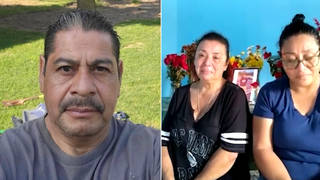

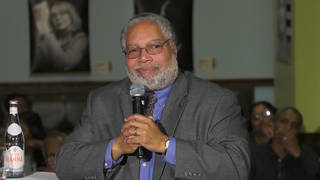

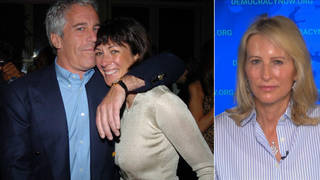
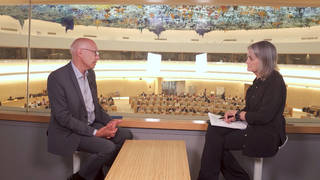

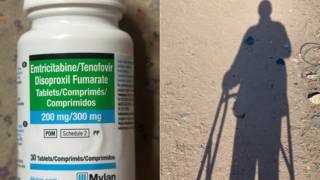
Media Options